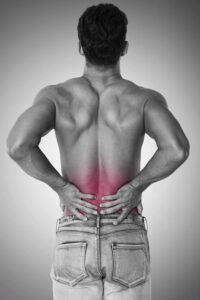Back pain is a common issue that can be caused by a variety of factors, most often benign musculoskeletal conditions. One of the leading causes is disc disease (degeneration or herniation of the intervertebral disc), a condition that affects the discs between the vertebrae, leading to severe pain in the lower back.

These discs act as shock absorbers, but age, improper movements, or excessive strain can cause degeneration or herniation, putting pressure on nerve roots and resulting in sciatica—pain that radiates down the legs.
However, back pain is not only due to disc disease. Other common causes include:
Since back pain can result from various factors, an accurate diagnosis is crucial to determine the most effective treatment plan.
Symptoms of lower back pain vary depending on the severity and location of the condition.
Recognizing symptoms early ensures prompt treatment and prevents complications.
Back pain can affect anyone, but with smart habits, you can protect your back and avoid pain.
By following these simple but effective tips, you can keep your spine strong and pain-free for years to come.
The treatment approach for a lumbar herniated disc depends on individual needs, considering age, lifestyle, and existing conditions.
Most cases of herniated discs can be treated without surgery, using a combination of therapies.
If symptoms persist beyond 6-8 weeks or worsen despite conservative treatment, surgery may be required.
With proper diagnosis and treatment, most patients recover successfully and regain normal daily function.
Back pain and lumbar disc herniation can be debilitating, but with the right prevention, treatment, and lifestyle changes, you can regain mobility and live pain-free.
If you are experiencing persistent or severe symptoms, consulting a specialist orthopedic doctor is the first step to recovery. Don’t let back pain control your life—take action today!